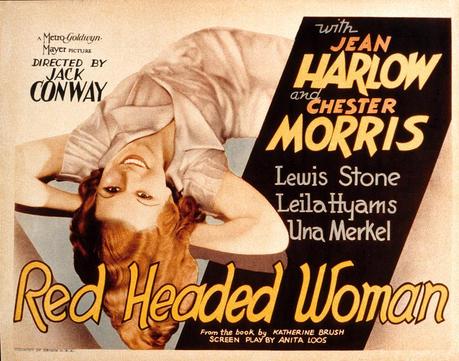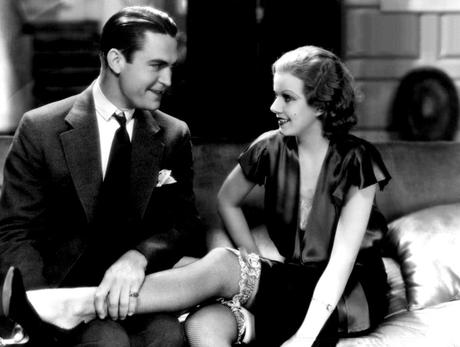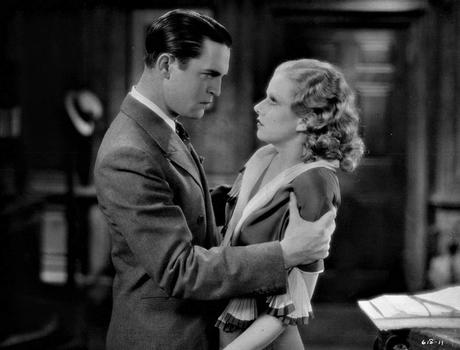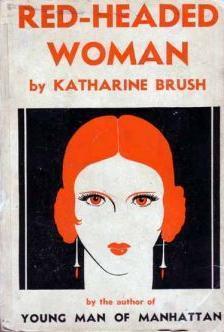
No conversation about pre-Code Hollywood would be complete without Red-Headed Woman. It’s easily one of the most notorious movies of the era. The tale of Lillian Andrews/Legendre, flawlessly played by Jean Harlow, and her unrelenting pursuit Bill Legendre, his money, and his social status certainly had plenty of content to scandalize audiences upon its release in 1932. But before it was a hit movie, it was a popular serialized story, written by Katharine Brush, that had appeared in the Saturday Evening Post before being released as a standalone book. But does the book live up to the reputation of the movie?
Book & Movie Differences
Given Red-Headed Woman‘s status as one of the ultimate pre-Code movies, I started the book expecting it to be full of content that would have been too much for the movie. Imagine my surprise when it turned out that the movie ended up making the story a bit more scandalous in some ways. A lot of what happens in the book does happen in the movie, but it’s reworked to make Lillian a more ruthless homewrecker and Bill more sympathetic. In the book, Lillian never says, “Do it again, I like it!” after being slapped by Bill Legendre. Lillian never puts a picture of Bill in her garter belt. The part about Lillian shooting Bill in a fit of rage? Created for the movie. And the part about Lillian ending up with a much older man, while also having an affair with her chauffeur, is only half true. She does end up with a rich man at the end of the book, just not as old. And the book version of Lillian would never deign to have an affair with a lowly chauffeur.
Overall, there’s a big difference between Lillian’s pursuit of Bill in the book compared to the movie. In the movie, Lillian is much more aggressive about it. In the first scene, she’s on her way to visit Bill at home knowing that his wife is out of town, even though she isn’t actually his secretary. She arrives at his house wearing the aforementioned garter belt with his picture in it, fully intent on seducing him. But in the book, Lillian is more about the long game.
In the book, Lillian isn’t officially Bill’s personal secretary — he doesn’t have one — but she makes a point of going above and beyond for him so that he essentially treats her as such. He thinks she’s just swell as a secretary, but Bill’s brothers, who also work for the company, think she’s lazy. Over time, she finds excuses to spend time with Bill away from the office, whether it’s visiting some of the company’s mines or getting rides home from him after work, knowing that they would be seen around town. People did, indeed, talk and Lillian loved it. Everyone assumed the affair had started earlier than it actually did. The affair didn’t actually begin until the night Lillian talked Bill into taking her out to dinner while Irene was away.

The book spends a great deal of time detailing Lillian’s obsession with Irene, but that gets played down significantly in the movie. If anything, the book shows Lillian thinking about Irene more than she thinks about Bill. Ultimately, it’s Irene’s lifestyle that Lillian wants; Bill just happens to be her means to get it. She wants her wedding to Bill covered in the paper like Irene’s was. She insists on going to New York on their honeymoon because it’s where Bill and Irene spent their honeymoon. She wants to be friends with Irene’s friends and go to the same country club Irene goes to. Lillian is livid when she finds out Irene is moving into an apartment near her new house with Bill. When Lillian stops into Sally’s beauty salon, Sally thinks to herself that Lillian will be asking for Irene’s favorite nail polish for her next manicure. Even before Lillian and Bill get married, she goes into Irene’s bedroom and considers leaving something behind, like a hairpin, just to make her presence known.
The movie movie also focuses less on Lillian’s problems with being welcomed by Renwood’s social elite. You do see it in the movie, but it’s less prominent than in the book. In the book, if Lillian isn’t obsessing over Irene, she’s absolutely furious over every single social slight she receives from Bill’s family and friends — and there are a lot of them. He drags his feet over introducing her to his friends and doesn’t say anything when his siblings exclude her from social events. When she buys a gift for Bill’s sister who had recently had a baby, he talks her out of sending it. There was an incident where Bill took Lillian to the country club and an employee, who had poor eyesight and lacked awareness of town gossip, said he mistook Lillian for Mrs. Legendre. Lillian was not amused, but everyone else was when they heard about it.
An important scene in the movie involves Lillian getting angry when all of her guests go over to Irene’s house after a party at her home, which does happen in the book. Only she doesn’t throw a fit afterward. Instead, she just becomes more determined to shock the town. The reason for the party at Lillian’s is also different. In the book, the party is an excuse for Bill’s friends to see the new house Lillian decorated. In the movie, the party is in honor of C.B. Gaerste, a very important business associate of the Legendre family. Lillian seduced Gaerste and talked him into to the party at her home because none of Bill’s friends would come otherwise. In the book, Gaerste has no connections to the Legendre family business, nor does he come to Renwood. He’s a magnate Lillian meets while on a trip to New York, which was paid for by Bill’s father to get rid of her for a while.

The book version of Bill Legendre is more passive than we see in the movie. In the movie, he tries harder to resist Lillian’s advances, does more to get her out of his life after their initial affair, and does more to end his marriage to Lil. But in the book, he’s depicted as a guy who has pretty much been handed everything in his life and just accepted it all without giving it much real thought. He works at the family business and married his high school sweetheart. So when Lillian comes along and offers something different, he mistakes attraction for love. As his marriage to Lil progresses and she’s not getting what she wants out of it, she’s the one actively trying to find a way out.
While the book version of Bill is more passive, the book version of Irene is much more proactive after learning about Bill’s affair. When she finds out, she tells him he’s made his choice and kicks him out of the house. But in the movie, it shows them making more of an effort to save their marriage. We also see Irene doing things like questioning what she had done wrong.
Is the Book Worth Reading?

Katharine Brush is a writer I’d really like to get to know better. At the height of her career, she was known for having a witty, incisive, and modern style of writing and Red-Headed Woman holds up very well because of it. Some of the references are now a bit dated, but her style of writing makes it a book that could easily be enjoyed by readers today. It’s easy to forget that you’re reading something that was first published 90 years ago. I definitely hope to read more of her work soon. If you’re a big fan of pre-Code movies, Red-Headed Woman is worth checking out, even if only for the connection to the movie.
As a big fan of the movie, I’ve often heard the challenges that went into adapting Red-Headed Woman for the screen. I’d heard all about how F. Scott Fitzgerald had worked on the screenplay, but his version was deemed too serious. Then Anita Loos was brought in to give it a lighter tone. After reading the book, I can understand how this would have happened. The book contains many statements which make it clear that Lillian was the town joke of Renwood. Even Sally, Lillian’s only friend in town, was amused by her ridiculous behavior. (Sally, by the way, is the kind of role Una Merkel was an absolutely perfect fit for.) But it’s often written about in ways that could get lost in translation. Especially if you’re trying to make sure audiences aren’t too sympathetic to someone like Lillian.
I already loved the work Anita Loos did on the screenplay for Red-Headed Woman, but reading the book actually helped give me an even greater appreciation for it. Loos took what was good about the source material and made it work for the screen, nailing the idea that Lillian is someone to be laughed at, not with. For example, the book often talks about how Lillian liked to draw attention to herself when driving through town. But a touch Anita Loos added was the part where Lillian drives through town with marching band music playing in the background. When she parks her car and turns off the radio, we find out the music wasn’t just part of the movie’s musical score — Lillian was turning her trip to the salon into a one-car parade for herself. And, of course, Jean Harlow plays the role to absolute perfection, making the whole thing even better. This is definitely an example of how good a book-to-movie adaptation can be, even if it doesn’t follow the book to the letter.
This review is part of the 2021 Classic Film Summer Reading Challenge hosted by Out of the Past. For more reviews on books related to classic film, be sure to follow the #ClassicFilmReading hashtag on social media.
